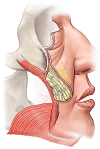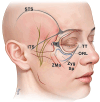Transtemporal Endoscopic Deep Plane Face Lift
- PMID: 39850537
- PMCID: PMC11756885
- DOI: 10.1097/GOX.0000000000006461
Transtemporal Endoscopic Deep Plane Face Lift
Abstract
Background: Facial aging involves multifactorial changes affecting the bone, superficial musculoaponeurotic system, fat pads, and skin, primarily manifesting as the downward displacement of these structures. The transtemporal endoscopic deep plane face lift (TEDPF) suggests a vertical lifting method, targeting these issues without a preauricular incision.
Methods: A retrospective study was conducted on 140 patients (133 women and 7 men) 33-67 years of age who underwent TEDPF from February 2020 to March 2023. Of these, 42 patients also received a neck lift. The surgical technique involved endoscopic dissection and vertical lifting and fixation of the superficial musculoaponeurotic system layer using specific suture points. An objective photographic analysis was performed by measuring preoperative and postoperative lower eyelid lengths to assess aesthetic outcomes.
Results: The follow-up period ranged from 18 to 36 months. Temporary frontal neuropraxia occurred in 5 patients, resolving within 3 weeks to 3 months. Revision surgery was required for 6 patients due to excess preauricular skin or temporal skin accumulation malar dimpling. Significant improvements were observed, especially in periorbital, nasolabial, and jowl areas, enhancing eye shape and reducing the need for lower blepharoplasty. Objective photographic analysis showed a significant reduction in lower eyelid length postoperatively, with a mean percentage reduction of 22.45% in eyelid length (P < 0.05).
Conclusions: TEDPF achieves effective vertical lifting for facial rejuvenation, minimizes scarring, and reduces surgery time. It provides notable aesthetic improvements with manageable complications, suitable for patients prone to keloids or seeking less invasive options.
Copyright © 2025 The Authors. Published by Wolters Kluwer Health, Inc. on behalf of The American Society of Plastic Surgeons.
Conflict of interest statement
The authors have no financial interest to declare in relation to the content of this article.
Figures







References
-
- Hamra ST. The deep-plane rhytidectomy. Plast Reconstr Surg. 1990;86:53–61; discussion 62. - PubMed
-
- Mendelson BC, Jacobson SR. Surgical anatomy of the midcheek: facial layers, spaces, and the midcheek segments. Clin Plast Surg. 2008;35:395–404; discussion 393. - PubMed
-
- Hamra ST. Composite rhytidectomy. Plast Reconstr Surg. 1992;90:1–13. - PubMed
-
- Mendelson BC, Freeman ME, Wu W, et al. . Surgical anatomy of the lower face: the premasseter space, the jowl, and the labiomandibular fold. Aesthetic Plast Surg. 2008;32:185–195. - PubMed
LinkOut - more resources
Full Text Sources
